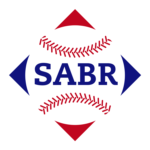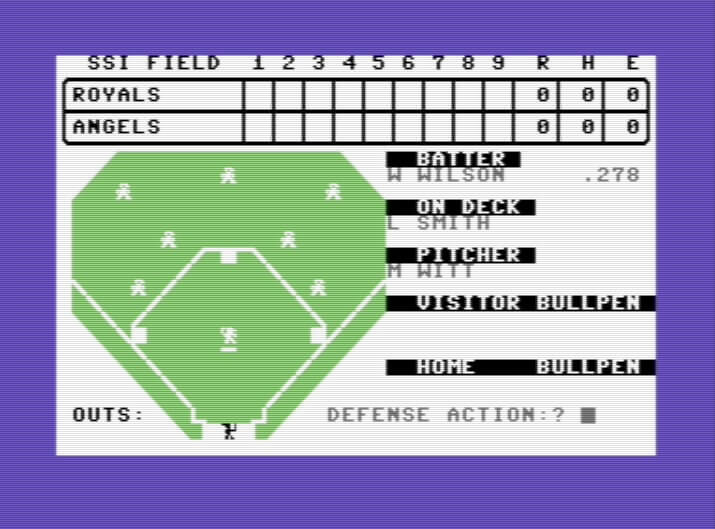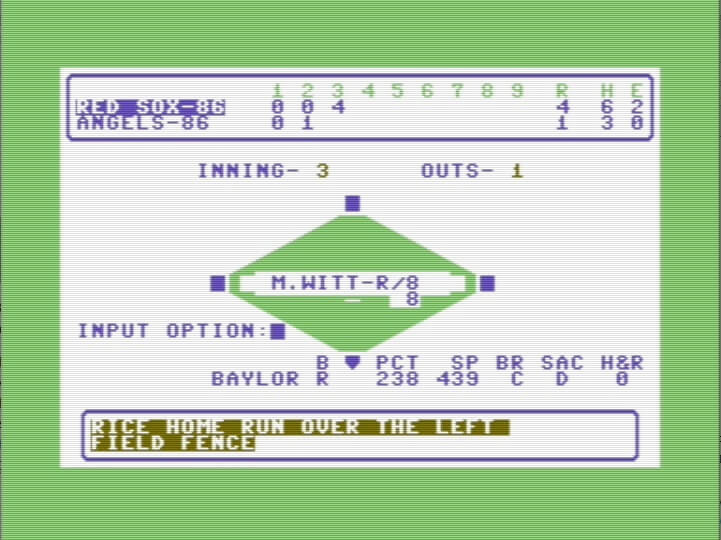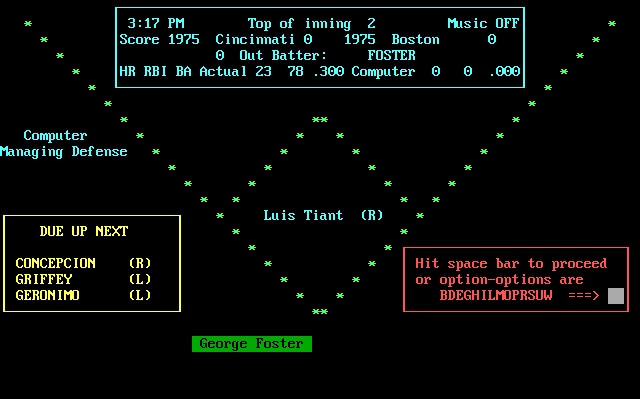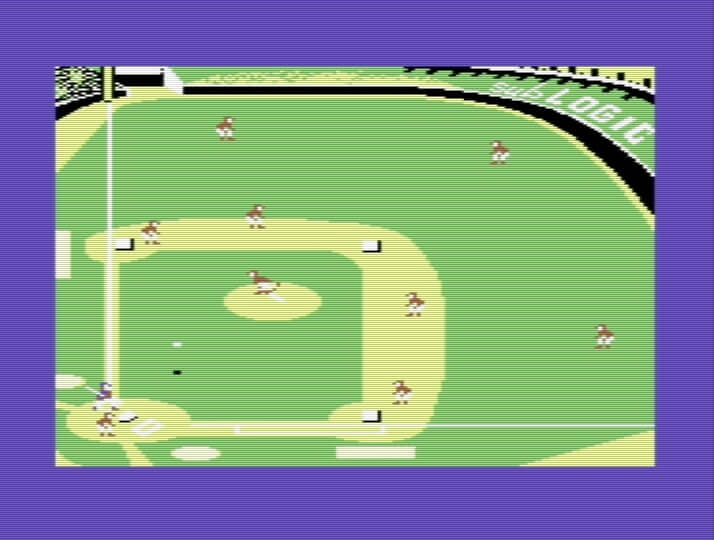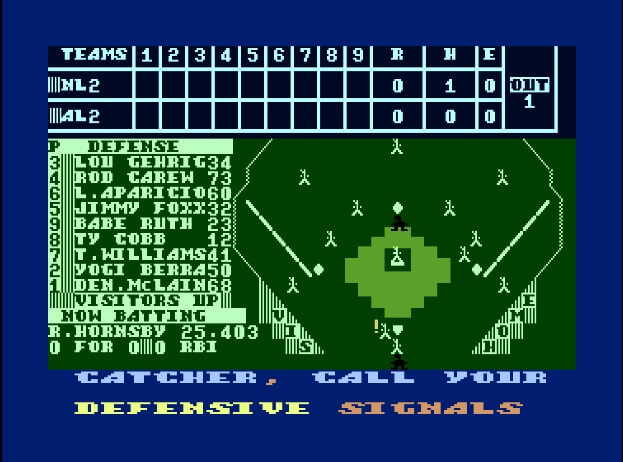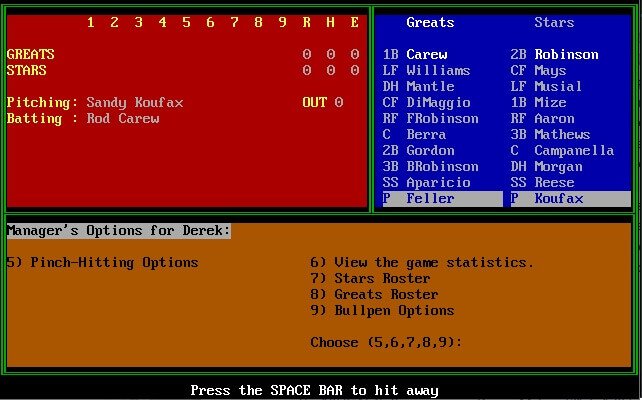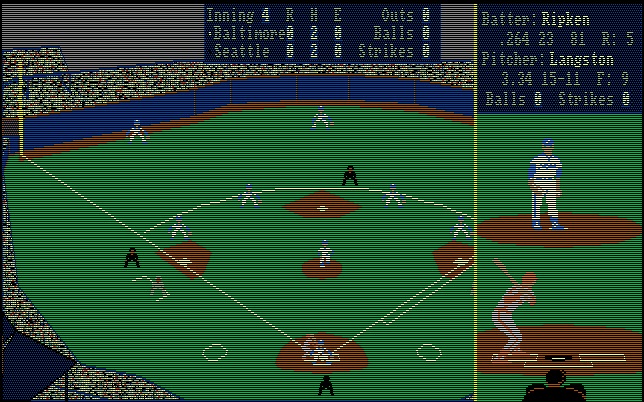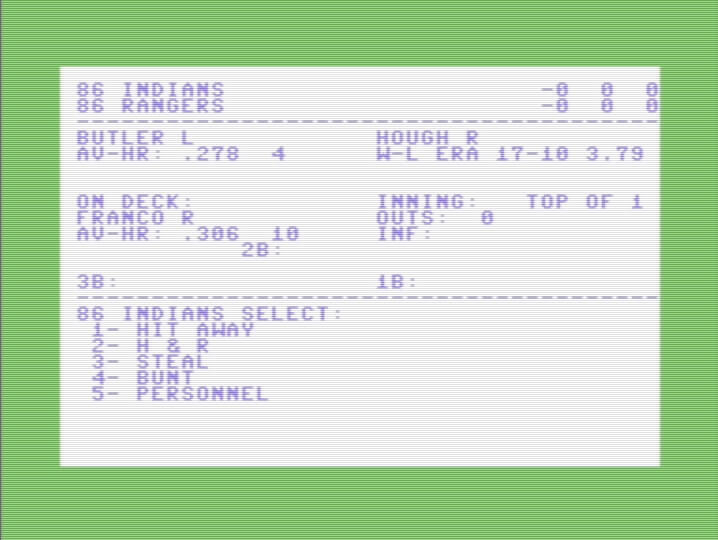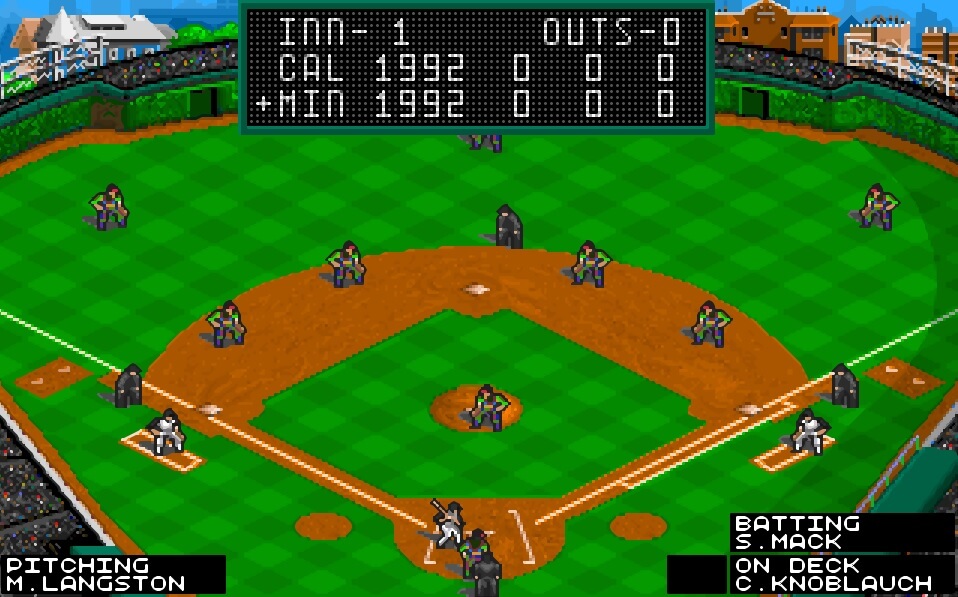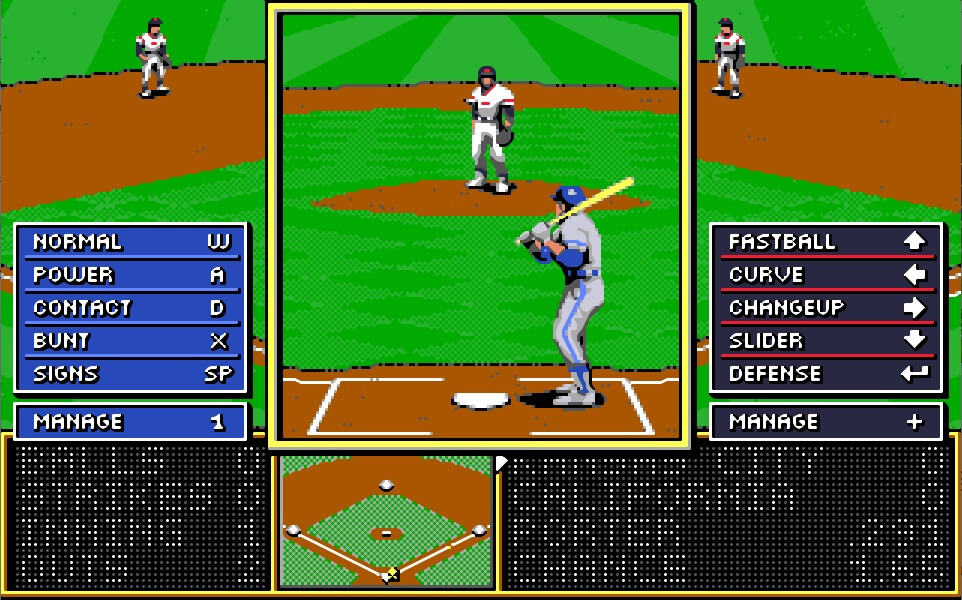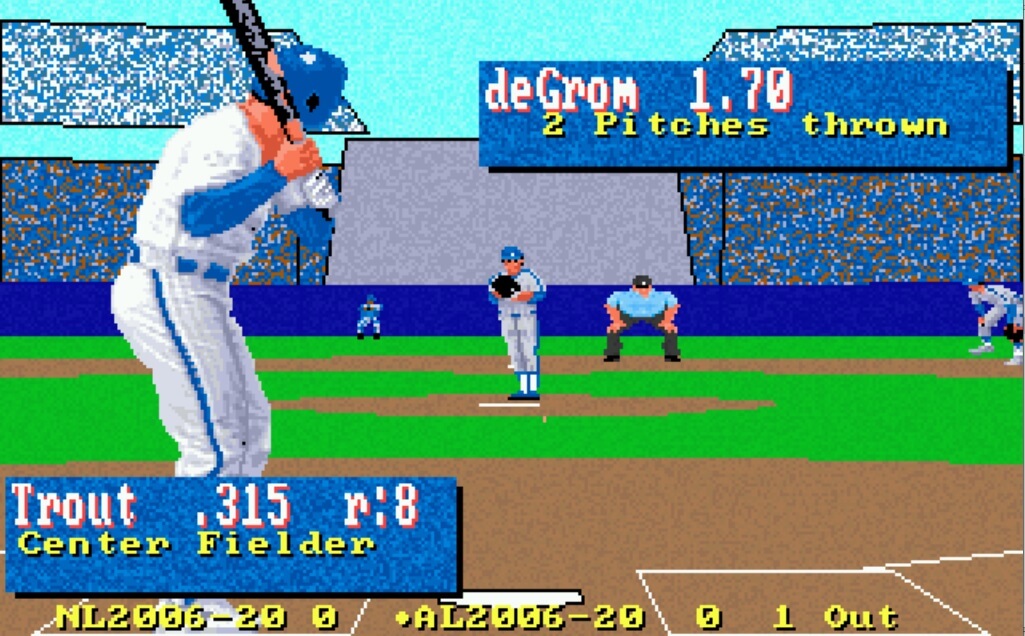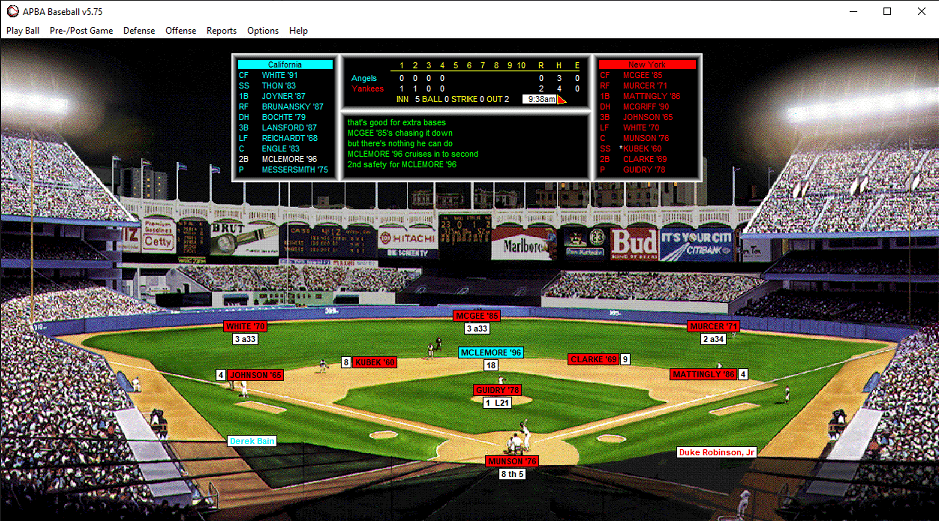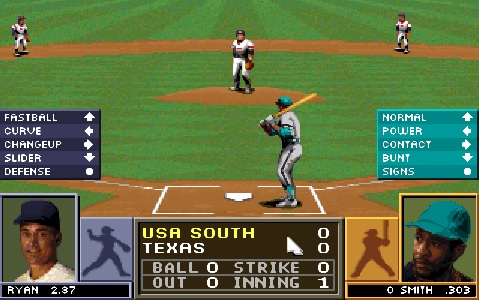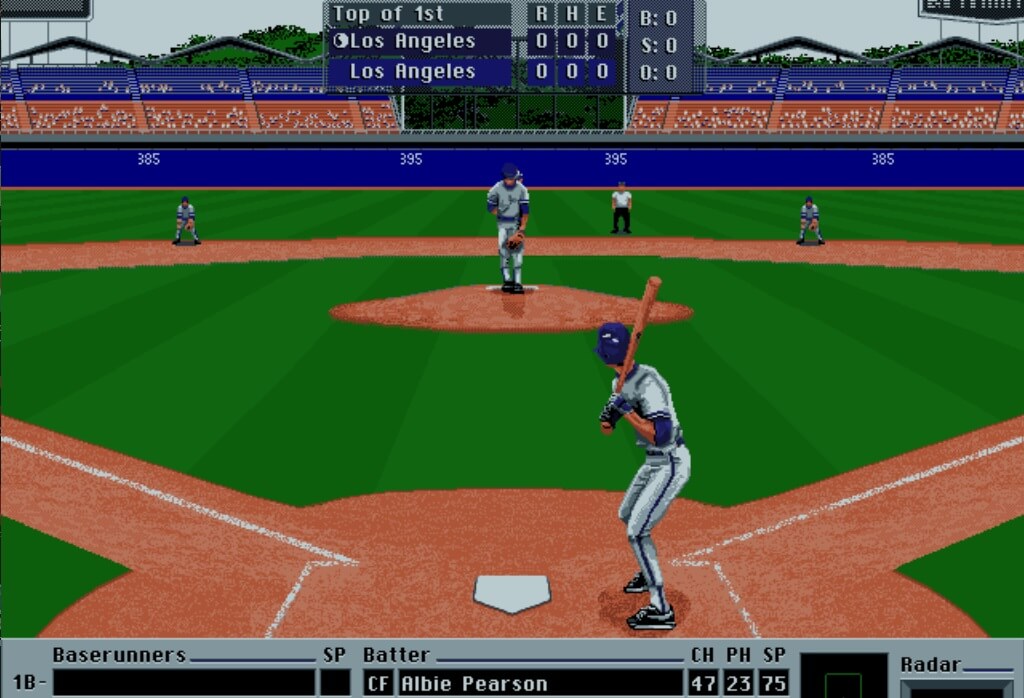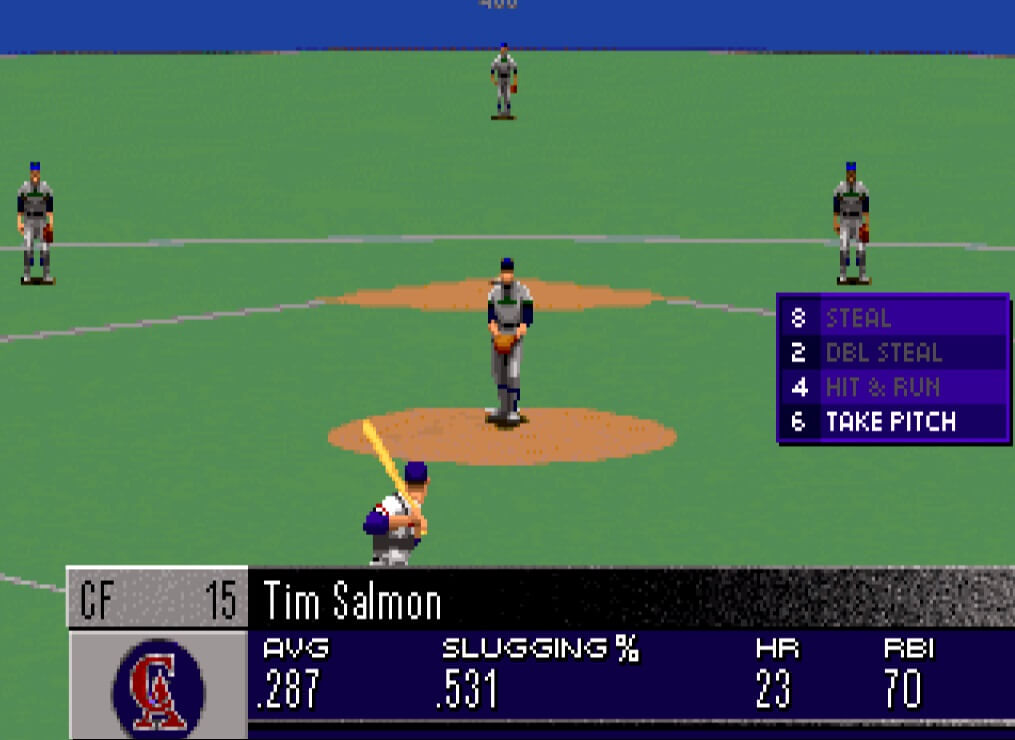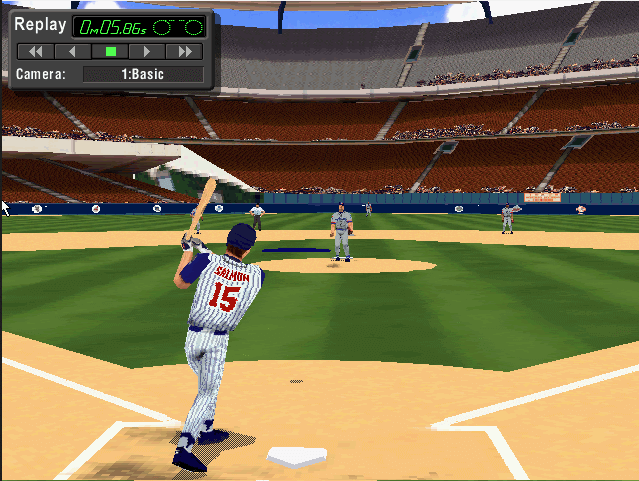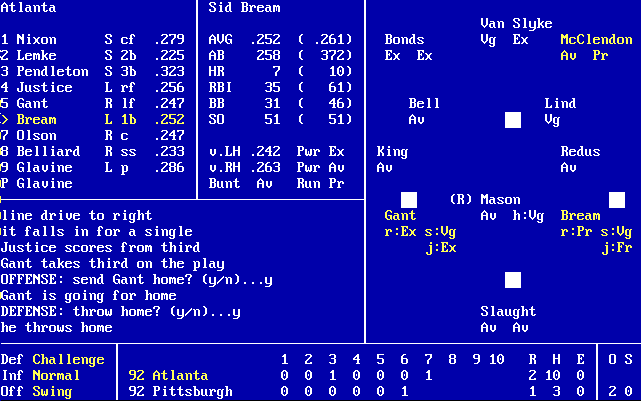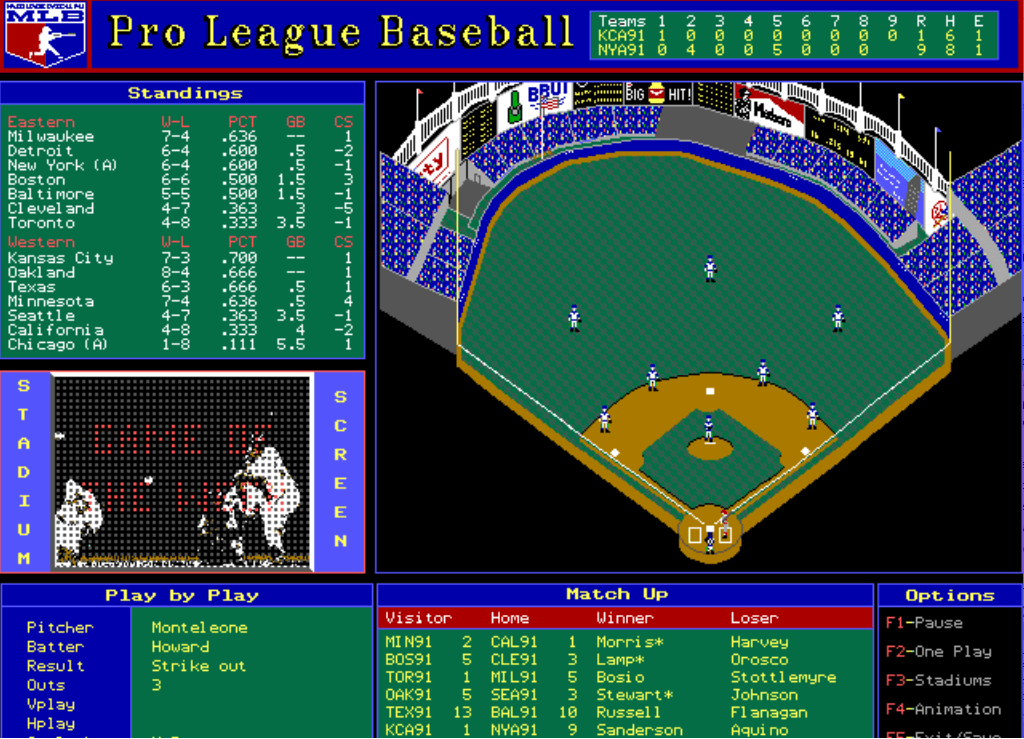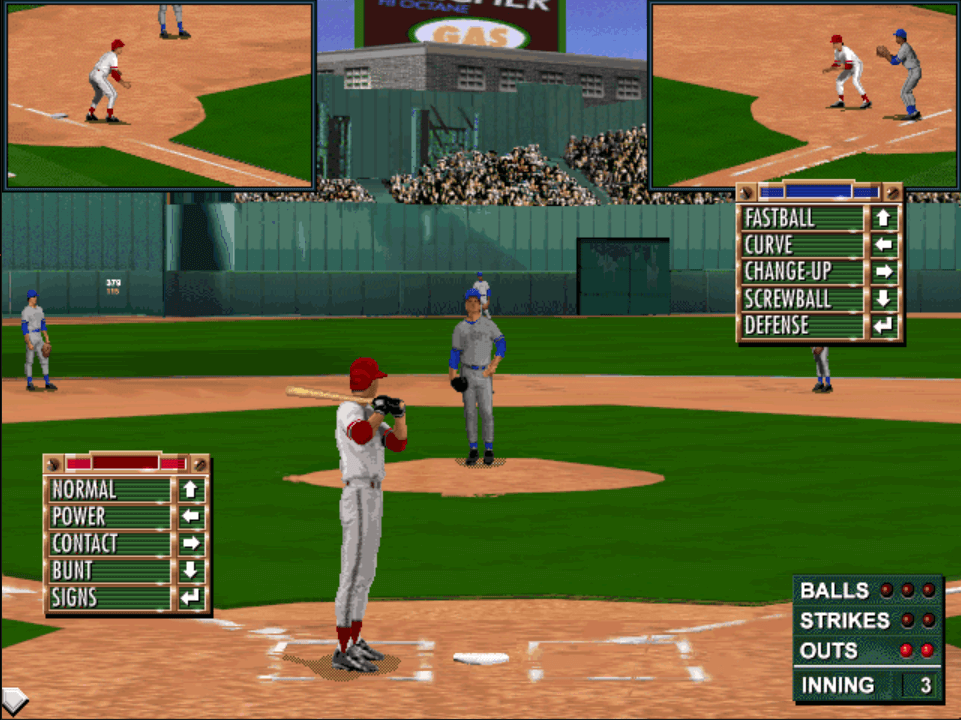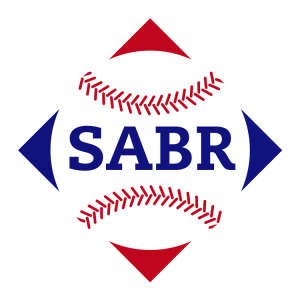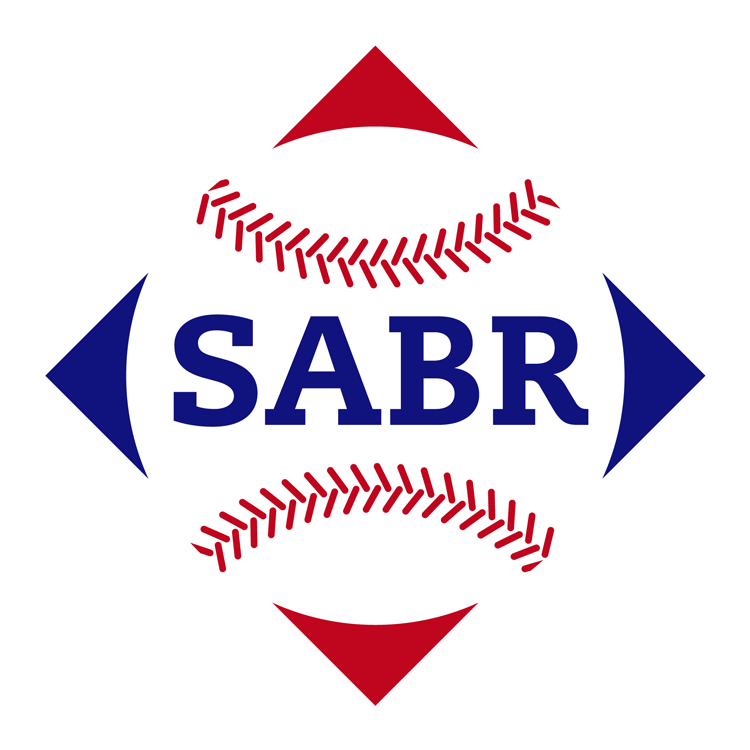This is the third entry in a series focusing on computer baseball simulations to supplement the chapter “Play Retro Baseball Video Games In Your Browser” from my Hardball Retroactive book along with the corresponding post at Hardball Retro. The series focuses on baseball simulations – games in which the primary emphasis is on managerial strategy and the ability to replay entire seasons with a degree of realism. Baseball video games that are strictly arcade representations of baseball (based solely on reflex and hand-eye coordination) are excluded.
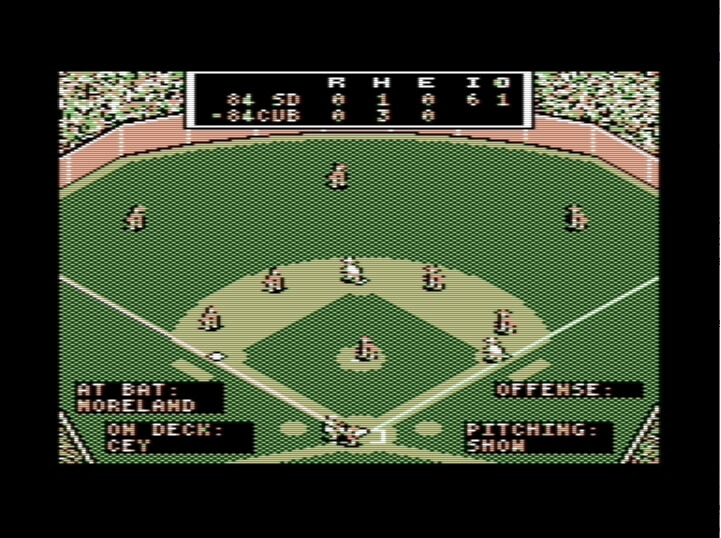
Publisher – MicroLeague Sports Association
Release Year – 1984
Platforms – Amiga, Apple ][, Atari 8-bit, Atari ST, Commodore 64, IBM PC
Credits
| Game Design: | Barry R. Morstain |
| Programming: | John I. Graybill, James A. Dorsman, Mark Baum, Stephen L. Cox, Eric A. Harlow |
| Statistics: | Paul J. Kelly, John E. Foskey |
Review
MicroLeague Baseball is the computer hardball simulation that consumed a significant percentage of my youth. I owned the game, GM/Owner and Box Score/Stat Compiler disks for my Commodore 64 and purchased the same disks several years later for my Apple ][e. My friends and I spent many hours with MicroLeague Baseball over a five-year period. The competition was fierce as the opposing managers sat next to each other and shared the keyboard. The defensive manager had to shield their view with the strategy card while the offense selected their play. Several managers looking for an edge resorted to cheating (partially or pretending to cover their eyes). We created numerous team and league disks and even composed a pair of teams from our stickball statistics! Due to a lack of a quick-play option, we never completed a full season but I always smile when I reminisce about the MicroLeague days.
In order to show the various features and offer a comprehensive review, I launched the Commodore 64 edition of MicroLeague Baseball – Box Score/Stat Compiler in the VICE emulator. The Main Menu appears following a passing glimpse of MicroLeague Stadium:
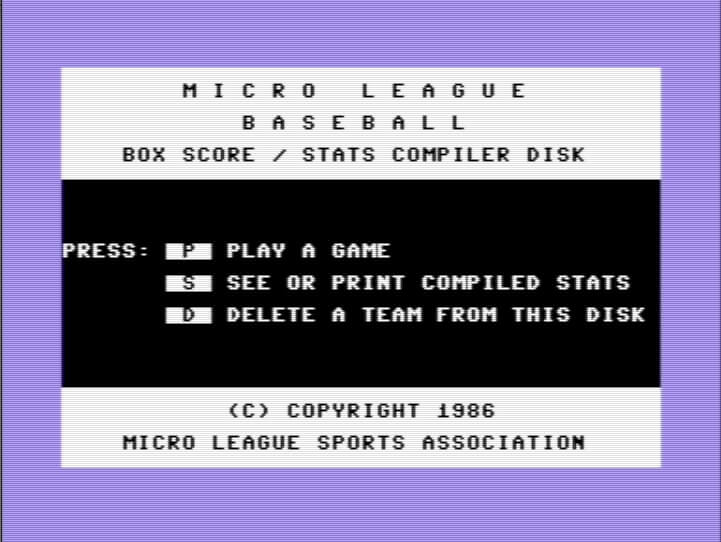
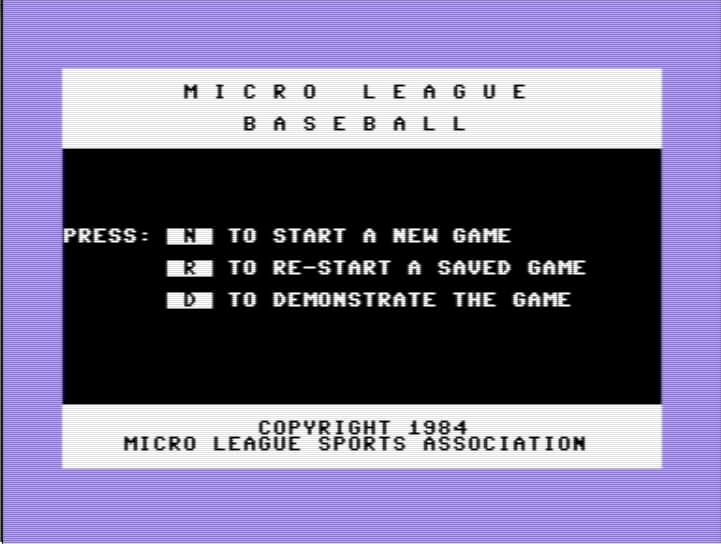
I chose ‘P’ to play a game, whereas I was prompted to place the Game Disk in the drive. Once the Game program loads, I selected ‘N’ to start a new game. You can choose from 25 Great Teams available on the Game Disk, or insert a Team Disk.
I scheduled a rematch of the 1984 National League Championship Series between the Cubs and Padres, utilizing the original lineups from each contest. A friendly reminder: before commencing each game, press the ‘R’ key to prevent players from running on and off the field after each inning. This will slice at least ten minutes off your total game time. The animation may have been amusing at first but the interminable wait detracts from the experience after repeated viewing.
Eventual 1984 NL Cy Young Award winner Rick Sutcliffe (20-6, 3.64) and Eric Show (15-9, 3.40) initiated the festivities with a pitcher’s duel in Game 1. In the bottom of the third inning, Rick Sutcliffe reached on a fielder’s choice (a sacrifice bunt in which the lead runner Larry Bowa was cut down at second). Sutcliffe lumbered into second on Bob Dernier’s groundout to Steve Garvey and advanced to third when second-sacker Ryne Sandberg laced a single to center field. Gary “Sarge” Matthews popped up to Alan Wiggins to end the threat. Sutcliffe carried a no-hitter into the sixth inning. Tony Gwynn slapped a clean hit between shortstop and third base with one out, but he was promptly caught stealing with a laser peg by the backstop Jody Davis. Show was lifted for pinch-hitter Bobby L. Brown as he was due to lead off the top of the eighth as the contest remained scoreless. Sutcliffe whiffed Brown and escaped further harm by inducing Garvey to ground out to shortstop after plunking Gwynn with 2 outs. Craig Lefferts came on in relief to begin the bottom of the 8th to do battle against the top of the Cubbies’ lineup. Dernier lofted a fly ball towards the right-field line that Gwynn misplayed into a two-base error. Sandberg launched a long ball into the stands in left-center, giving Chicago a 2-0 lead. Lefferts recovered to set the next 3 Cubs down in order. Lee Smith began to warm up in the Cubs’ pen as Sutcliffe marched to the mound in the hopes of twirling a shutout. He retired Graig Nettles and Terry Kennedy on soft line drives to the infield and then got Kevin McReynolds on a lazy fly ball to Dernier for the final out.
A pair of lefties squared off as Mark Thurmond (14-8, 2.97) took the hill against Steve “Rainbow” Trout (13-7, 3.41) in Game 2. Ryne Sandberg blasted a shot off the ivy in left-center which Kevin McReynolds played into a triple. Gary Matthews scored Sandberg on a groundout to second base. Chicago struck again in the second frame when Larry Bowa drove in Jody Davis with a single to the right field gap. In the home half of the fifth inning, Trout hammered a two-bagger off the wall in left-center to knock in Bowa for the third run. Thurmond recovered to finish 5 frames and then exited the game for a pinch-hitter (Bobby L. Brown) to start the sixth inning. Rich “Goose” Gossage entered in the bottom of the sixth as the Friars trailed 3-0. Ron Cey doubled with one out and Davis followed with a solid safety to right, placing runners at the corners. Leon Durham beat out a slow dribbler to Alan Wiggins and Cey skipped home with the fourth run. After Bowa grounded into a fielder’s choice, Trout stroked his second hit to left, extending the lead to 5-0. Bob Dernier hit a two-hopper to Luis Salazar to conclude the inning. The “Goose” was cooked when Cey belted a 3-run bomb to left-center following a pair of walks to begin the bottom of the seventh. Trout held the Padres hitless through 7 1/3 innings when Salazar drilled a hard ground ball back through the box and into center field. Sandberg booted Garry Templeton’s bouncer to second, but Trout wriggled off the hook. Dave Dravecky pitched a scoreless eighth inning, yielding only a base knock to Dernier. Trout caught McReynolds looking at a back-door slider to complete his one-hit shutout! The Cubs took a 2-game lead as the series headed to San Diego.
Dennis Eckersley (10-8, 3.03) opposed fellow veteran right-hander Ed Whitson (14-8, 3.24) in Game 3. Ryne Sandberg tattooed a solo shot down the left field line to put the Cubs on the board in the top of the first. Whitson issued back-to-back walks to Gary Matthews and Leon Durham. Keith Moreland ripped a single up the middle, scoring Matthews. San Diego averted disaster when Ron Cey and Jody Davis were retired on fly balls to finish the frame. The Friars finally plated their first run of the series in the bottom of the third. Whitson led off with an opposite-field single and Alan Wiggins bunted for a hit. Tony Gwynn grounded into a fielder’s choice, leaving runners at the corners with one out. Steve Garvey slapped a single back through the box to drive home Whitson. Graig Nettles rocked “Eck’s” next offering, clearing the left-center field for a three-run blast! Whitson cruised through 7 innings, yielding only 4 hits while Eckersley settled down and pitched effectively for 6 innings. Rich Bordi came on in relief to start the seventh. Wiggins doubled up the left-field alley and Gwynn laced a single to center, increasing the Padres’ lead to 5-2. Garvey walloped Bordi’s next offering into the bleachers as the Friar fans went nuts! After retiring Nettles on a pop fly, Terry Kennedy poured gasoline on the fire when he crushed another batting-practice fastball from Bordi into the right-center field seats. The Cubs mercifully relieved Bordi, bringing in veteran Dick Ruthven to put out the dumpster fire. Durham swatted an opposite-field big-fly in the top of the eighth, cutting the deficit to 8-3. Moreland doubled and attempted to score on a Davis single to left field, but he was gunned down at the dish on a strong throw from Carmelo Martinez. Kennedy walloped a three-run bomb down the right field line off Ruthven in the bottom of the 8th as the San Diego squad extended their advantage to 11-3. Whitson completed the contest on a harmless fly ball to McReynolds off the bat of pinch-hitter Gary Woods.
The Game 4 matchup showcased Scott Sanderson (8-5, 3.14) versus southpaw Tim Lollar (11-13, 3.91). Lollar immediately got into trouble in the opening frame, loading the bases with walks to Bob Dernier and Gary Matthews along with an Alan Wiggins error on Keith Moreland’s potential double-play grounder. Lollar got Ron Cey on an infield fly for the second out but subsequently walked Jody Davis to force in a run. Leon “Bull” Durham smoked a single between shortstop and third, plating Matthews and Moreland. Larry Bowa lofted an easy fly to left to retire the side with the Cubs claiming a 3-0 advantage. Chicago threatened in the top of the third when Cey lined a base knock to right which skipped off Tony Gwynn’s glove. “Mr. Padre” recovered in time to peg Moreland at the plate attempting to score all the way from first. Kevin McReynolds led off the bottom of the fifth with an opposite-field wallop to reduce the Padres’ deficit to 3-1. Warren Brusstar relieved Sanderson as Chicago took the field in the bottom of the eighth. Bobby L. Brown, batting for Lollar, singled between Cey and the new shortstop Tom Veryzer. One out later Gwynn delivered a base hit to right-center to plate Brown and bring the go-ahead run to the plate. Lee Smith entered the contest looking for a 5-out save. Moreland corralled Steve Garvey’s can of corn for the second out. Graig Nettles bounced into a fielder’s choice as Veryzer elected to go the short route to Ryne Sandberg to retire the side. San Diego’s skipper inserted portsider Craig Lefferts to oppose the #9 hitter Smith followed by the top of the Cubs’ batting order. Lefferts worked around a one-out knock by Dernier. After whiffing Sandberg for out # 2, the Padres called a pitchout and nailed the Cubs fleet-footed center fielder to end the threat. Terry Kennedy walked on 5 pitches against Smith to start the bottom of the ninth. McReynolds belted a curveball into right-center and Kennedy lumbered into third. With the infield playing in to cut off the tying run, Carmelo Martinez went down swinging for the first out. Garry Templeton blooped Smith’s next offering down the right-field line as Kennedy tallied the tying run, but Moreland rifled a shot to third to cut down McReynolds. Smith recovered to strike out pinch-hitter Tim Flannery, yet the Padres were alive and kicking as the game headed to extra innings. Dave Dravecky took his warm-up tosses as the Chicago bench shook the heads in stunned silence. Facing the heart of the Cubs order, Dravecky set them down 1-2-3. The top of the Padres’ lineup prepared to do battle against Tim Stoddard, but they proved to be no match for the towering right-hander. Tom Veryzer cuffed a two-out seeing-eye grounder between Wiggins and Garvey. Steve Lake, batting for Stoddard, ripped a base hit through the hole on the left side and pinch-runner Henry Cotto scurried from first to third. Bob Dernier hammered Dravecky’s next offering between Nettles and Templeton as the Cubs reclaimed the lead. Greg A. Harris trotted out to the mound, attempting to limit the damage. “Ryno” crushed Harris’ offering deep into the left-center field bleachers, extending the Cubbies’ advantage to 7-3. Harris then plunked Gary Matthews in frustration but he remained in the game and got Moreland to mercifully ground into a fielder’s choice to complete the half-inning. Nettles stepped to the dish to face Rich Bordi. Cey snared a line drive off Nettles’ bat for the first out. Kennedy scalded an atom ball to Durham and the Friars were down to their final out. McReynolds clubbed a long drive towards the right field wall, but defensive replacement Henry Cotto settled under it just shy of the warning track. The Cubs won the pennant!!!
Ratings
Graphics – [3] A generic ballpark is displayed with the scoreboard at the top of the screen listing the teams, runs, hits, errors, inning and outs. The bottom left corner shows the current and on-deck batter while the bottom right names the current pitcher along with a prompt to input your strategy option on offense or defense. The play-by-play is delivered 2 or 3 lines at a time on the scoreboard while the on-screen action occurs on the field. The players move accurately and the physics of the ball in flight are captured adequately, although specific plays will soon become apparent as there are no variations from the pre-programmed outcomes. That is, the trajectory of the ball for each event type will always follow the same flight path and the patterns will become easily discernable. The attention to detail enhances the experience and boosts the graphics rating. The defensive whips the ball around the horn after a strikeout and convene at the mound to conference with the pitcher and manager. Runners slide into bases and batters scamper off the field after making an out.
Sound – [2] The tail-end of the “Star-Spangled Banner” plays prior to the start of every game. “Charge!” blares from the speakers during rallies. Hits, walks, runs, outs, and strikeouts produce a variety of bloops, beeps and razzes. A descending 3-note sequence denotes the end of an inning. The Seventh-Inning Stretch features a brief rendition of “Take Me Out to the Ball Game”.
Strategy – [3] Most plate appearances are resolved by showing the pitch which results in a ball in play, walk or strikeout. Exceptions include a pitchout, foul bunt or a stolen base attempt. In a 2 player game, the offense is prompted to enter their strategic selection, followed by the defense. The offense has several additional options when there are runners on base: swing away with aggressive or safe running, steal, hit & run, sacrifice bunt. With no runners on base, the offense can only choose to swing away or bunt for a hit. The defense has 4 pitches (fastball, curveball, slider, off-speed/changeup) and 4 strategy options: pitchout, corners in, infield in, intentional walk. Either manager can view the lineup and pitching screens by pressing the ‘9’ key while the ‘0’ key triggers a mound visit on defense. You may save a game in progress or restart a previously saved game.
Artificial Intelligence – [2] The computer manager will generally pinch-hit and replace the pitcher at appropriate intervals in the game. MicroLeague Baseball does not utilize left/right split stats, so the manager does not take the platoon advantage into account.
Box Score – [3] The post-game box score consists of at least 4 pages: the visitor and home offense results, pitching outcomes for both teams, and individual listings for errors, extra-base hits, stolen bases, etc. All of the standard pre-USA Today newspaper-style statistics are included. The final line score is omitted, which makes it difficult to reconstruct when each team scored their runs. The user has the ability to print the box score or compile statistics. If you choose the Compile option, you are prompted to select the teams or create new teams if this is the first time that you are compiling statistics for a particular team. You can view compiled stats by selecting ‘S’ from the main menu (See or print compiled stats). This provides 3 screens worth of offensive statistics along with 2 pitching screens. The box score / stat compiler disk does not keep track of the standings.
Rosters – [1] – Each team consists of a 25-man roster (15 batters and 10 pitchers). Each team disk includes a “Reserve List” roster which grants the General Manager the flexibility to temporarily swap out from an existing team’s roster.
Statistics – [3] – The General Manager / Owner Disk provides the user with a range of options to customize team disks. Among the available tasks – copy teams from another disk, delete or rename teams on the current disk, create a new team, view teams or verify team’s status. You can edit stats or change a roster for existing teams. Additional Season-by-Season, Special Edition and Franchise History disks were offered for purchase. In addition to the standard statistics, each player is assigned a fielding rating at their primary and secondary position (if applicable) between 0 (poor) – 3 (excellent). Every player receives a speed rating between 1 (slow) – 5 (fast).
Usage/Injuries/Ejections – [1] – Injuries, ejections and fatigue do not occur in the game and player usage is not a factor.
Ballparks / Park Factors – [1] – The simulation does not appear to account for any park factors and you do not have the ability to select different ballparks.
Commentary – [2] – Play-by-play text appears in the scoreboard as the pitch is delivered and continues one line at a time while the play is in progress. There’s not much variety here… once you’ve played a few games, you’ll have the majority of the commentary and the corresponding graphics memorized.
Scale: Ratings from 1 (worst) to 5 (best)
Total Score: 21 out of 50
Observations
MicroLeague Baseball represented a leap forward in graphics and sound from SSI Computer Baseball and Computer Statis Pro Baseball. The text descriptions provided additional flavor but still fall a bit short. I heartily recommend MicroLeague Baseball to replay a short series but would probably look elsewhere if you’re looking to re-create a full season’s worth of games.
Please add a comment below if you spent a significant amount of time and/or have any recollections of MicroLeague Baseball.
Screenshots
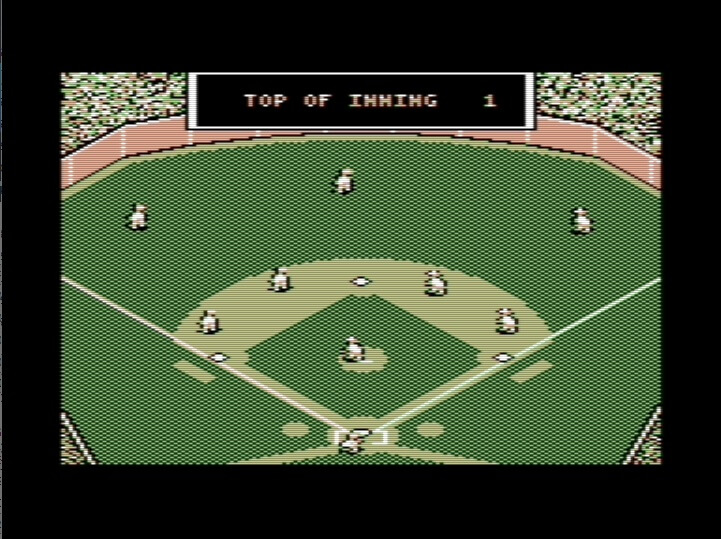
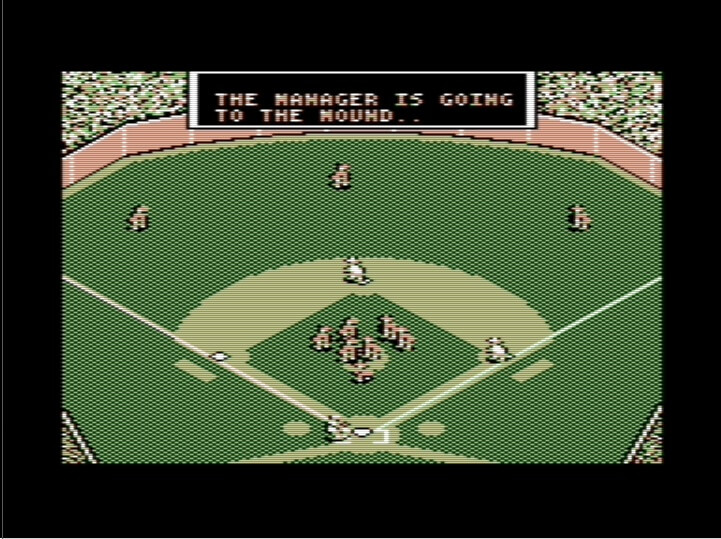
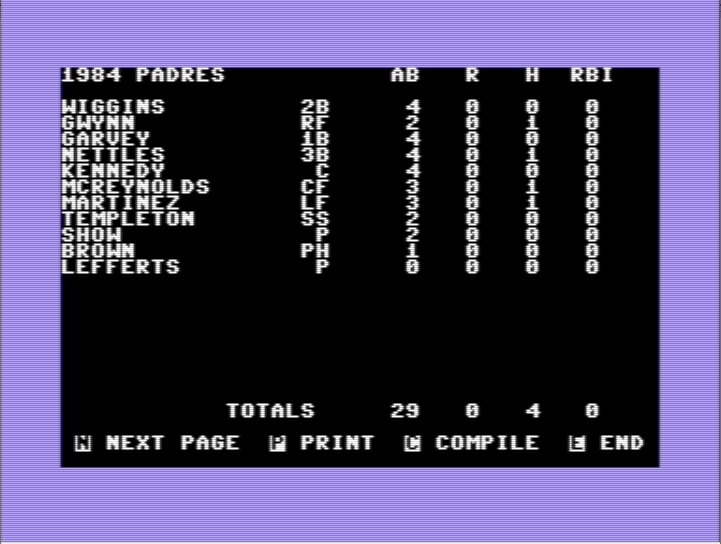
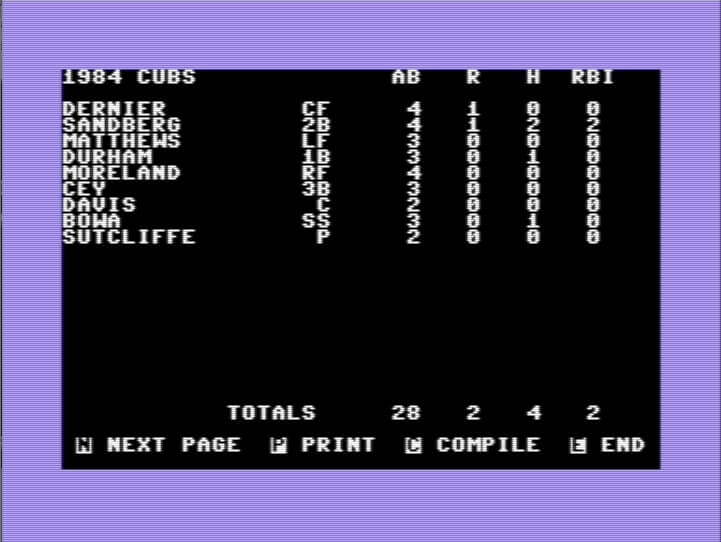
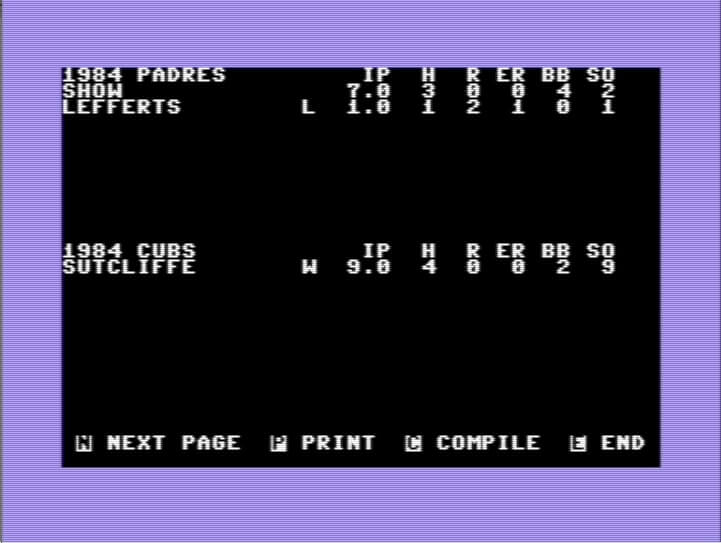
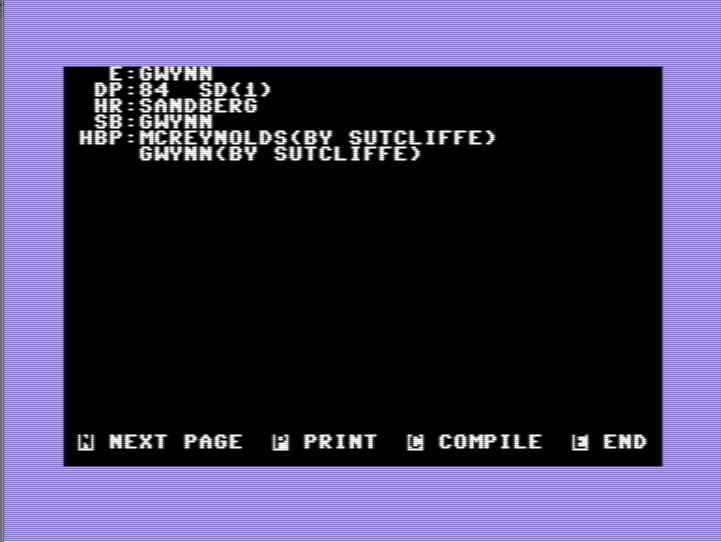
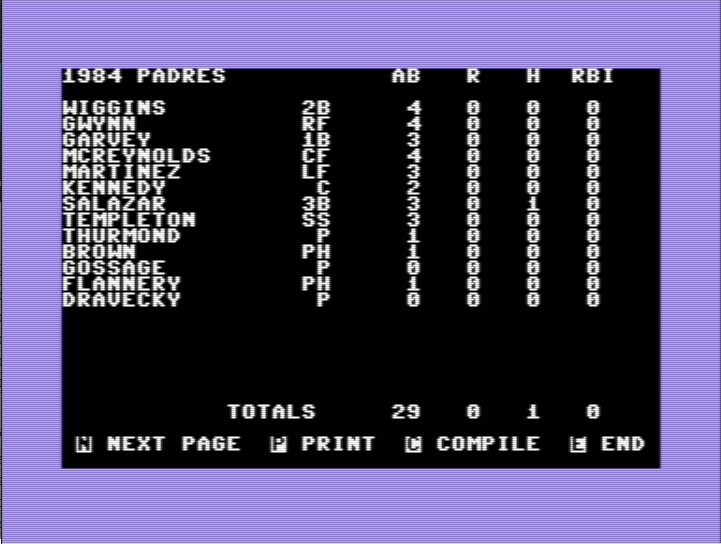
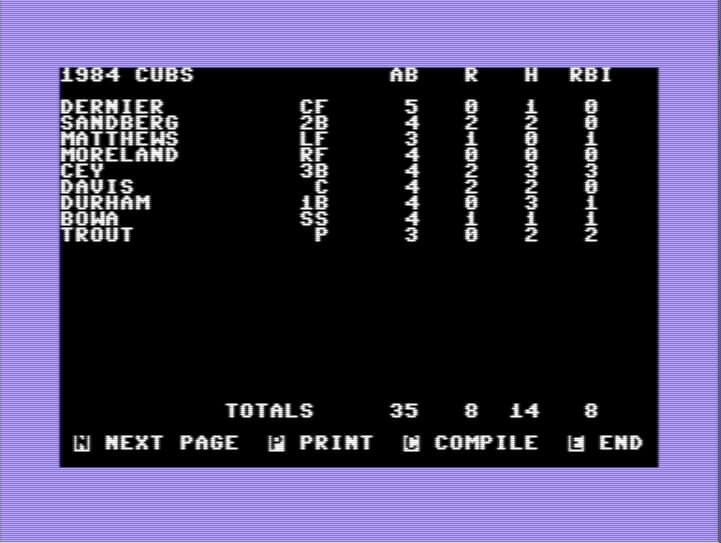
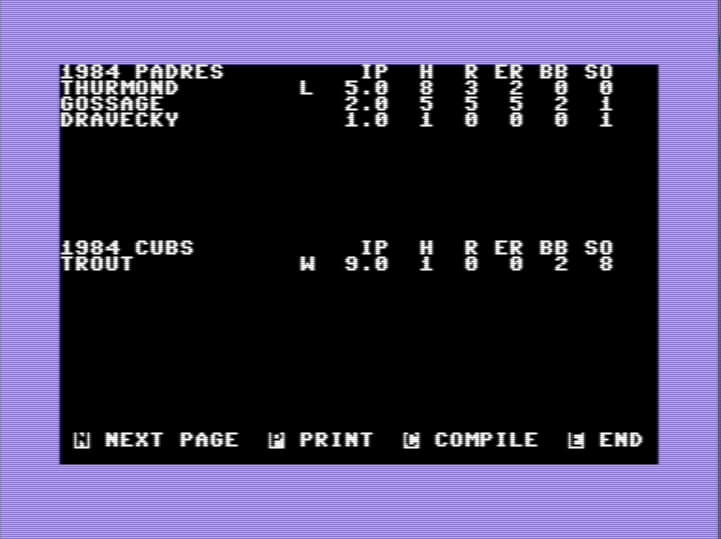
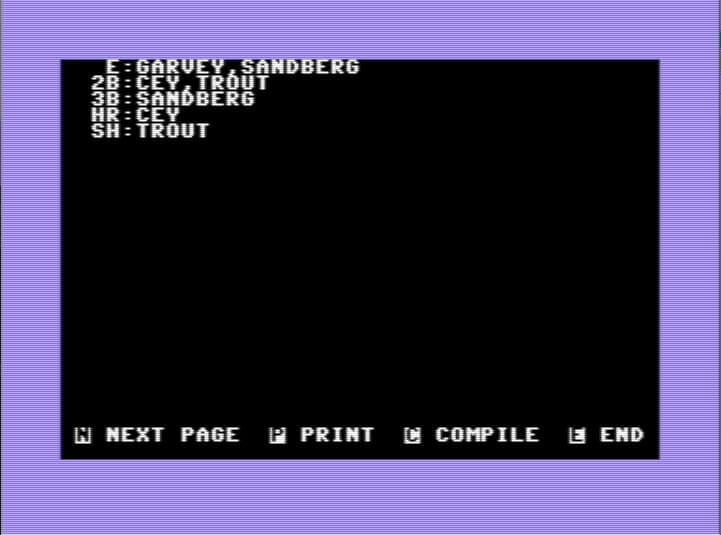
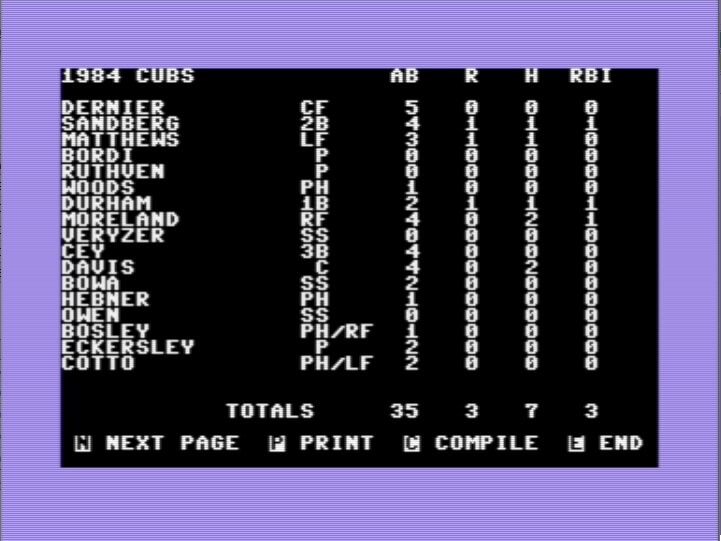
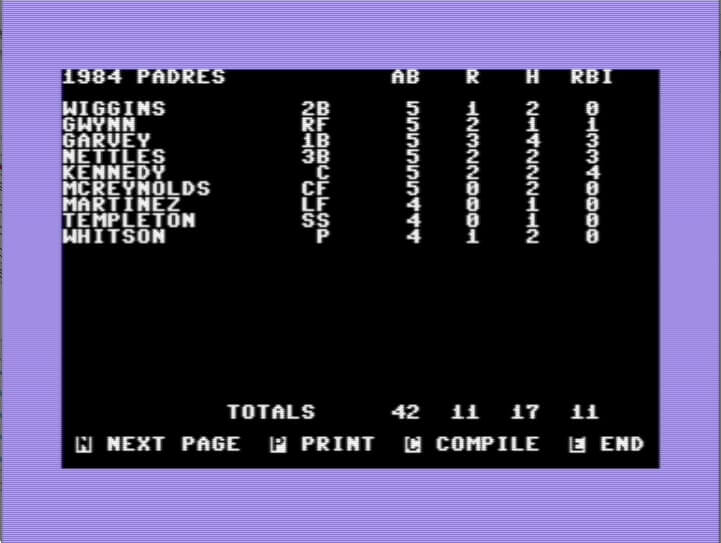
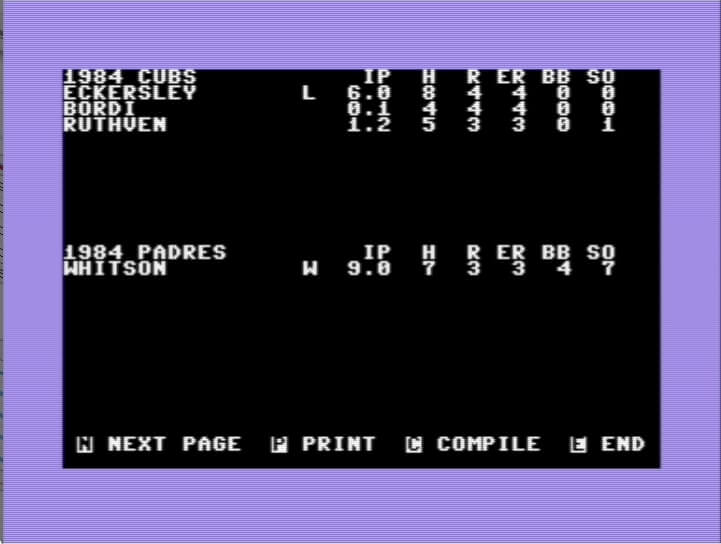
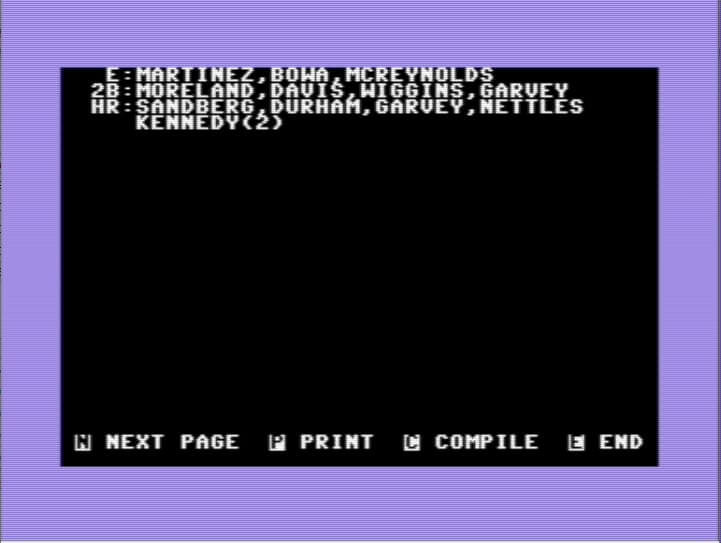
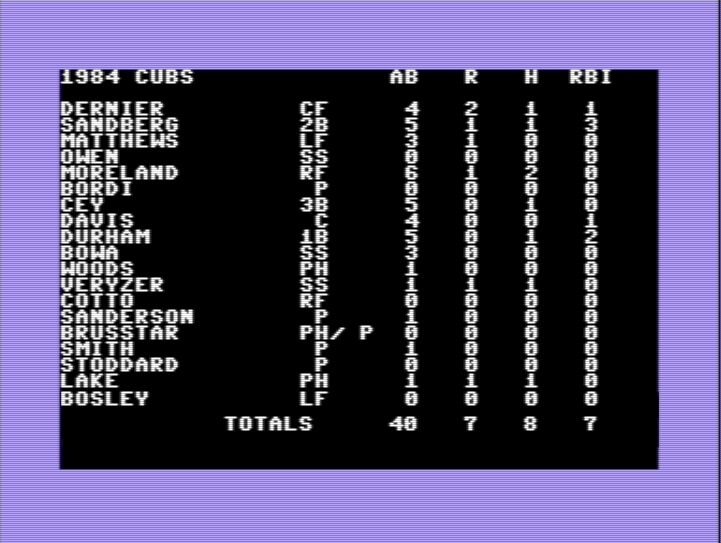
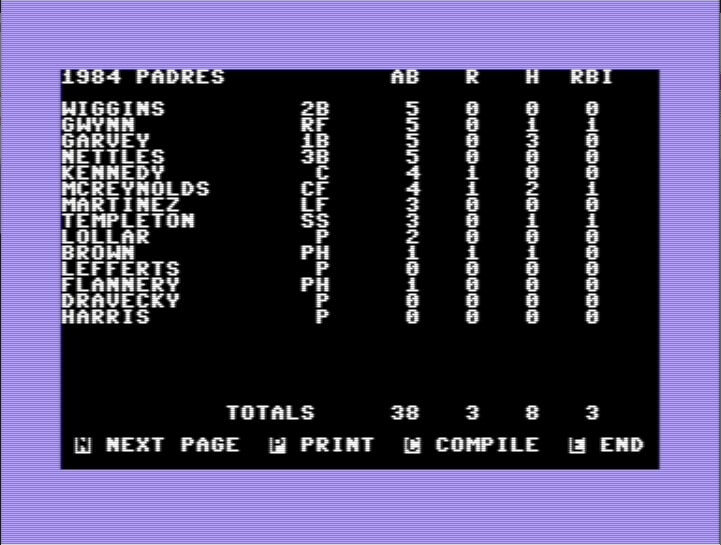
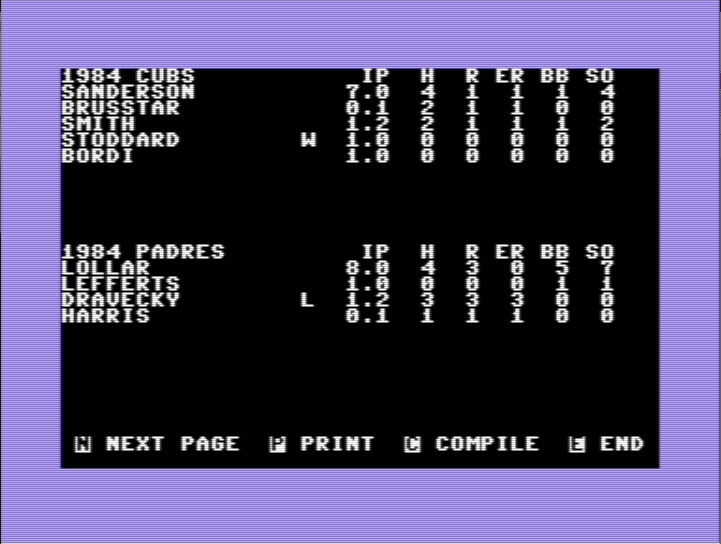
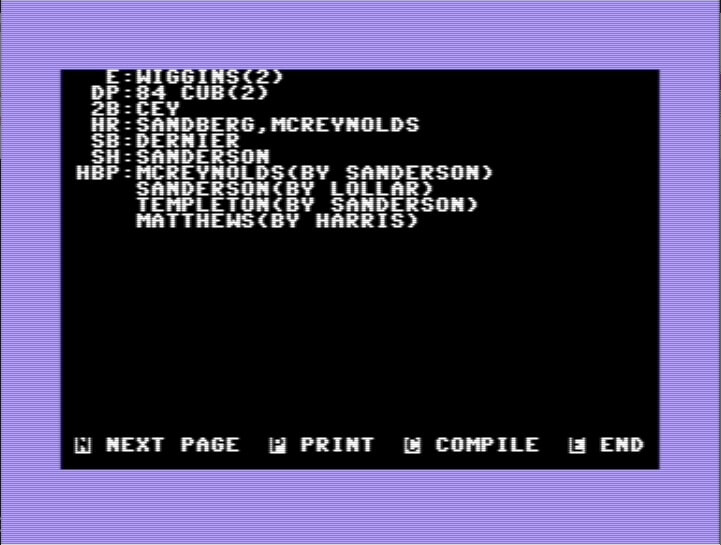
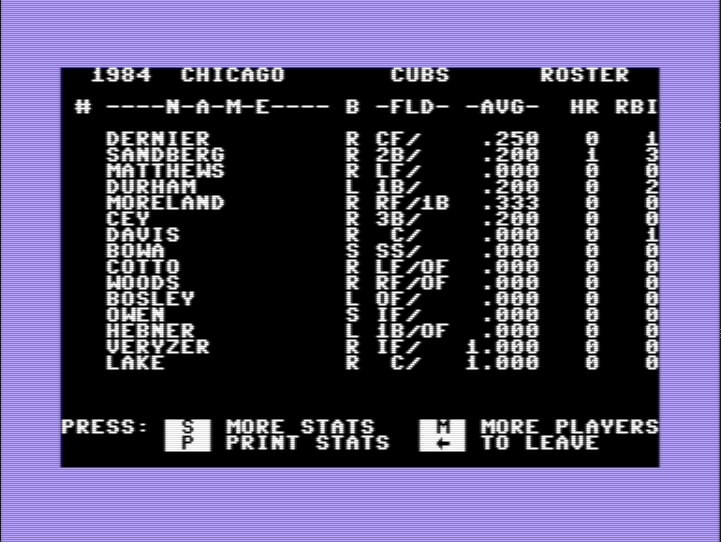
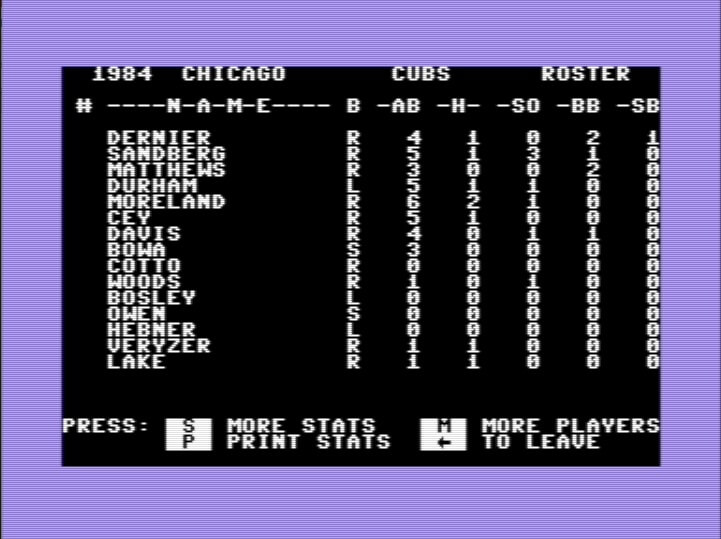
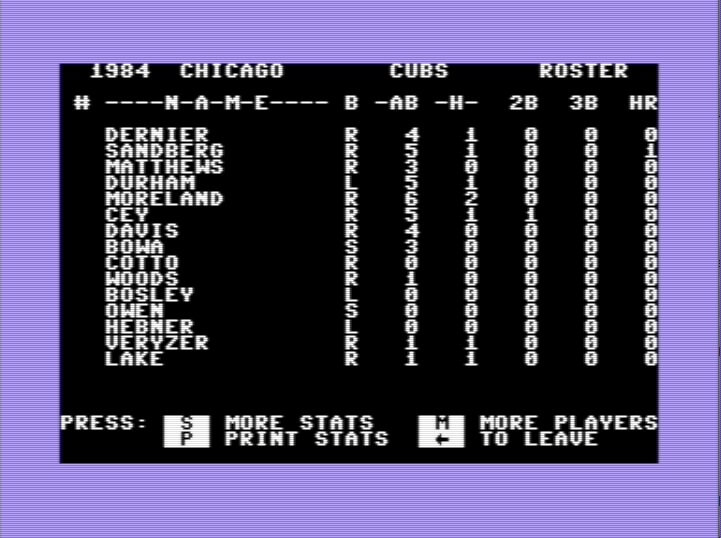
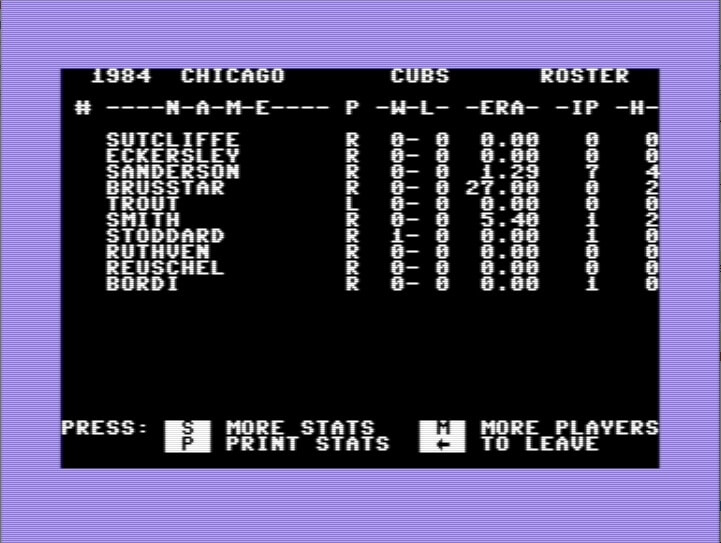
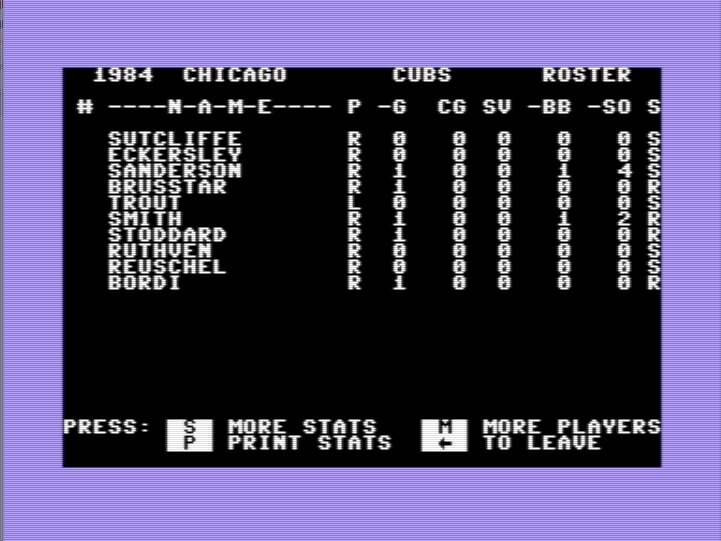
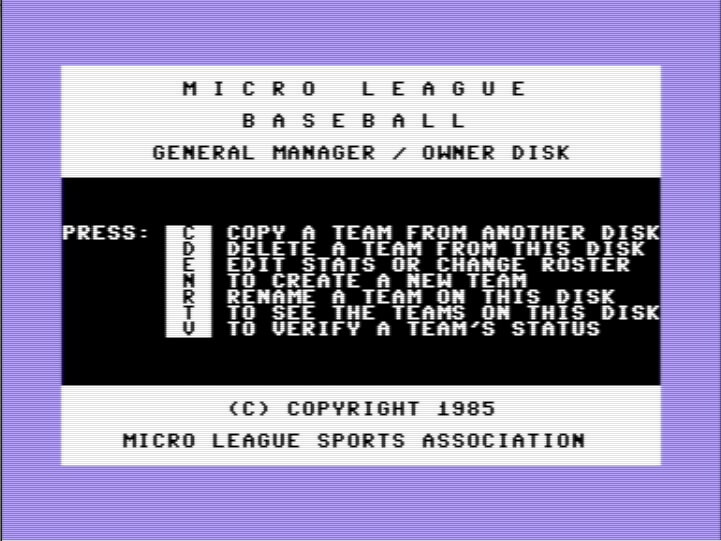
Articles in the Series
Additional Links
Play MicroLeague Baseball in your browser! –
Archive.org – MicroLeague Baseball (Apple ][)
Playthrough – HardballRetro
Trunzo, James V. “An Interview With the Designer of MicroLeague Baseball.” Computer Gaming World. Volume 28. May 1986. p22-23. http://www.cgwmuseum.org/galleries/issues/cgw_28.pdf
Oxner, Bill. “Play Ball!” Computer Gaming World. Volume 5.3, June-July 1985, p25.
http://www.cgwmuseum.org/galleries/issues/cgw_5.3.pdf
MicroLeague Baseball manual – https://www.scribd.com/document/119942396/MicroLeague-Baseball
https://www.mobygames.com/game/c64/microleague-baseball/credits
http://www.stadium64.com/gameinfos/microleaguebaseball/microleaguebaseball.htm
http://www.stadium64.com/gameinfos/microleaguebaseball/microleaguebaseball.htm
https://en.wikipedia.org/wiki/MicroLeague_Baseball
https://www.youtube.com/watch?v=bDkz8n9i8e8 (MicroLeague Baseball for the Apple II,
video by Highretrogamelord)
About the Author
I am a New Jersey native with a passion for baseball, statistics, computers and video games who enjoys spending quality time with his family.
“Hardball Architects – Volume 1 (American League)“, published in July 2020 and
“Hardball Architects – Volume 2 (National League)”, published in April 2022, examine the trades, free agent acquisitions, draft picks and other transactions for the 30 Major League Baseball franchises, divided into a 2-volume set. Both books are available in paperback and digital (Kindle) format at Amazon.com. All key moves are scrutinized for every team and Sabermetric principles are applied to the roster construction throughout the lifetime of the organization to encapsulate the hits and misses by front office executives. Team performances are analyzed based on transaction type with graphs depicting the WAR (Wins Above Replacement) in every decade. Individual results for each player-transaction is charted over the duration of their stint with the franchise. Every team chapter includes All-Time Rosters and Single-Season Leaders based on transaction type. The Team Trade Record chronicles the WAR and WS (Win Shares) accumulated by players acquired in comparison to those traded to opposing teams. The opening chapter is devoted to the Evolution of the General Manager and incorporates a discussion with former Dodgers GM Fred Claire (along with former Angels and Red Sox GM Mike Port and current Reds GM Nick Krall in Volume 2) on a variety of front office topics.
“Hardball Retroactive”, published in June 2018, is available in paperback and digital (Kindle) format at Amazon.com. Hardball Retroactive is a modest collection of selected articles that I have written for Seamheads.com along with my Baseball Analytics blog since 2010. Exclusive content includes the chapter on “Minors vs. Majors” which assesses every franchise’s minor league successes and failures in relation to their major league operations.
“Hardball Retrospective” is available in paperback and digital (Kindle) format at Amazon.com. Supplemental Statistics, Charts and Graphs along with a discussion forum are offered at TuataraSoftware.com. In Hardball Retrospective, I placed every ballplayer in the modern era (from 1901-present) on their original teams. Using a variety of advanced statistics and methods, I generated revised standings for each season based entirely on the performance of each team’s “original” players. I discuss every team’s “original” players and seasons at length along with organizational performance with respect to the Amateur Draft (or First-Year Player Draft), amateur free agent signings and other methods of player acquisition. Season standings, WAR and Win Shares totals for the “original” teams are compared against the real-time or “actual” team results to assess each franchise’s scouting, development and general management skills.
Don Daglow (Intellivision World Series Major League Baseball, Earl Weaver Baseball, Tony LaRussa Baseball) contributed the foreword for Hardball Retrospective. The foreword and preview of my book are accessible here.
“Hardball Retrospective – Addendum 2014 to 2016” supplements my research for Hardball Retrospective, providing retroactive standings based on Wins Above Replacement (WAR) and Win Shares (WS) for each “original” team over the past three seasons (2014-2016). Team totals from 2010 – 2013 are included for reference purposes. “Addendum” is available in paperback and digital (Kindle) format at Amazon.com.
NOTE: Original article posted on the Hardball Retro website, September 14, 2019.
